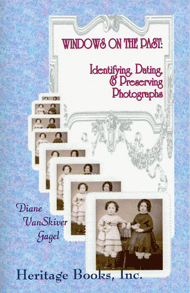 Over the past fifteen or so years, I have repeatedly heard or participated in many discussions, sometimes heated, over the best treatment and care for both older and newer photographs. The crux of the discussions often centering around digital photography for new images, and archiving of all type of photographic media, digital or otherwise. As the years have passed, the market has been flooded with newer, more advanced digital cameras; effectively, pushing the film camera into the annuals of history. In addition, methods for capturing and preserving older media into digital files has improved, with many people turning to an all digital storage solution. However, this does not change the need for genealogists to develop skills in identifying and dating old photos or learning to preserve old paper, glass, and tin-based images.
Over the past fifteen or so years, I have repeatedly heard or participated in many discussions, sometimes heated, over the best treatment and care for both older and newer photographs. The crux of the discussions often centering around digital photography for new images, and archiving of all type of photographic media, digital or otherwise. As the years have passed, the market has been flooded with newer, more advanced digital cameras; effectively, pushing the film camera into the annuals of history. In addition, methods for capturing and preserving older media into digital files has improved, with many people turning to an all digital storage solution. However, this does not change the need for genealogists to develop skills in identifying and dating old photos or learning to preserve old paper, glass, and tin-based images.
Dating and identifying old family photos is as popular a topic today as it has ever been. Yet, how often do researchers consider the medium in which a photo has been preserved may not be as important as the image itself in dating a picture. As we migrate images from paper, tin, glass, or other media, to digital copies, how will our children know what type of image was the original? Interestingly enough, living in the digital age, it never really occurred to me to consider how often people took older photos, like daguerreotypes or ambrotypes, and had them “preserved” on paper, as cabinet cards, or as tintypes.
Fortunately, Diane VanSkiver Gagel considered this very question. On the back cover of her book, Windows on the Past: Identifying, Dating, & Preserving Photographs, Gagel identifies this very issue, noting in the 1860s photographers commonly advertised that they could make tintypes or cabinet cards from older photos. Makes me wonder how many people argued, even in the late 1800s and early 1900s, the relevance of “updating” their photos to the latest “technology.”
More importantly, is Diane gives consideration to the type of media, but maintains the critical need to evaluate the image itself for those important clues that not only date the image, but may suggest that it has been reimaged at some point. Like other photo detectives, Gagel describes dating photos as a four step process:
- Identify the photographic process
- Date the photographer’s years of operation
- Identify and date fashion worn in the image
- Date any props found in the image
In her book, Gagel make it clear that only after steps 3 and 4 are completed should anyone then prescribe a date to an image. This book covers all the standard photographic methods from daguerreotypes on. Different methods are examined for dating photos. Preservation techniques are also covered.
Table of Contents
Dating Our Photograph Collection
Identifying and Dating: Paper Photographs
Researching the Photographer
Dating Costumes 1840-1900
- 1840-1850
- 1850-1860
- 1860-1870
- 1870-1880
- 188-1890
- 1890-1900
Preservation of Our Photographs
Using the Photograph Analysis Chart
Bibliography
Order Windows on the Past: Identifying, Dating, & Preserving Photographs from Family Roots Publishing; Price: $16.66.